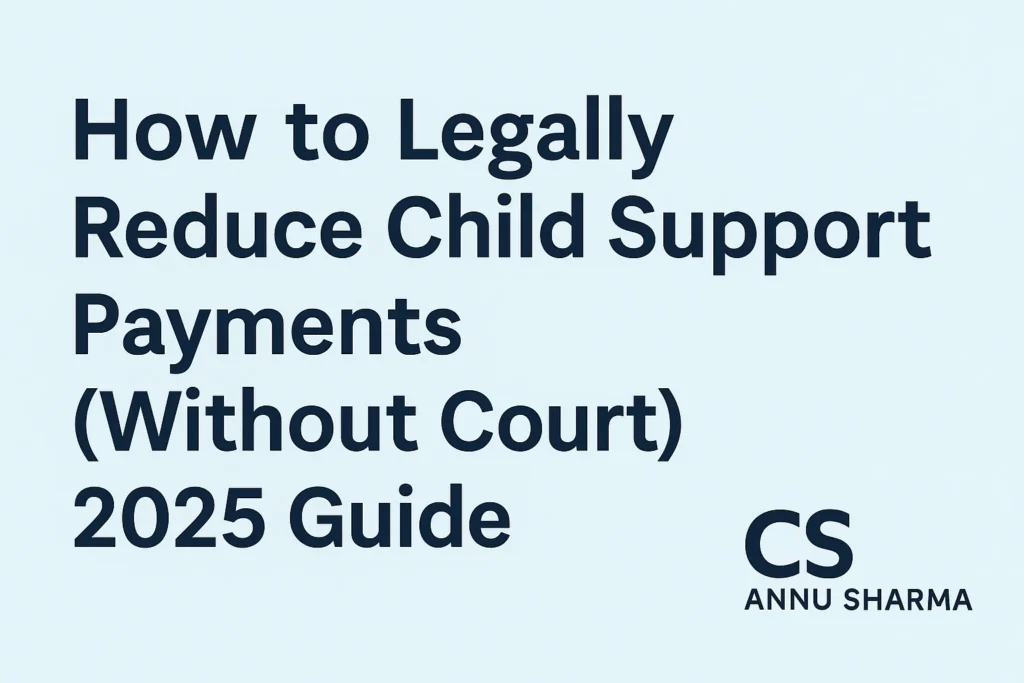How to Legally Reduce Child Support Payments?
Reduce Child Support Payments: This means finding ways to lower the amount of child support you’re required to pay, but doing it in a way that is:
- Legally allowed under your state or country’s child support laws
- Recognized by both parents, and ideally documented
- Not considered avoidance or abandonment
It emphasizes that you’re not dodging responsibility — you’re just trying to adjust it based on real, provable changes in your situation (e.g., job loss, medical bills, inflation).
Table of Contents
✅ “(Without Court)”
This part means you’re avoiding a courtroom battle or formal court filing. Instead, you’re:
- Reaching a mutual agreement with the other parent
- Possibly using mediation, written agreements, or parenting apps
- Avoiding expensive legal fees and long delays
This approach works best when both parents can communicate and co-operate in the child’s best interest.
Are you feeling financially overwhelmed by your monthly child support payments? You’re not alone. Many parents ask the same question: Can I reduce child support payments without going to court? The good news is — yes, it’s possible, legally and peacefully, if done the right way.
In this 2025 guide, we’ll walk you through practical, legal, and court-free methods to reduce child support, so you can still support your child while keeping your finances stable.
📈 Why Parents Look to Lower Child Support Payments
Child support payments are often set based on income and circumstances at the time of the original court order. But life changes:
- Job loss or pay cuts
- New family responsibilities
- Rising cost of living
- Health issues
If you’re facing one or more of these challenges, reducing your child support payment may not only be smart — it might be necessary.

⚖️ Is It Legal to Reduce Child Support Without Going to Court?
Yes — if both parents agree.
You cannot simply stop paying or lower the amount on your own. But if you and the other parent reach a mutual written agreement, you can adjust the payments legally — even without a courtroom or lawyer.
⚠️ Important: It’s always safer to document everything in writing and get it notarized. If possible, file it with your local child support enforcement agency or court.
🧩 7 Smart & Legal Ways to Reduce Child Support Payments (Without Going to Court)
1. 🤝 Negotiate a New Agreement with the Other Parent
Direct communication is the simplest way. If you and your co-parent have a civil relationship, discuss your financial difficulties honestly.
Tip: Offer to make non-cash contributions like paying for medical insurance, school fees, or extra-curriculars instead of cash payments.
2. 📜 Draft a Private Child Support Agreement
Once you both agree, put it in writing. This agreement should include:
- New payment amount
- Start date of the change
- Duration (temporary or permanent)
- Signatures of both parents
- Notarization (highly recommended)
3. 💻 Use Co-Parenting or Legal Document Apps
Many apps help you create and track agreements between co-parents legally. Some of the top tools include:
| App Name | Features | Cost |
|---|---|---|
| OurFamilyWizard | Document sharing, message tracking | Starts at $99/year |
| Custody X Change | Parenting plans, payment tracking | Varies |
| TalkingParents | Secure messaging, record keeping | Free + Premium |
These apps create a paper trail and can help in court later if needed.
4. 🧾 Offer Alternate Support (In-Kind Contributions)
Instead of a cash reduction, offer to:
- Pay for daycare or school fees
- Cover medical bills or insurance
- Buy clothes, food, or educational materials
Make sure everything is receipted and approved by the other parent.
5. 📉 Show Proof of Changed Financial Circumstances
Even outside court, showing documents like:
- Recent pay stubs
- Layoff letters
- Medical expenses
- Bank statements
…can help the other parent understand your situation better and agree to a new amount.
6. 📬 Write a Formal Letter Requesting Support Modification
If speaking face-to-face is hard, a well-written letter can be more effective. Include:
- Why you’re requesting a change
- How long you need the change
- What you can afford now
- Offer of alternative support
Want a free template? Let me know, and I’ll send one.
7. 💬 Consider Mediation (Instead of Court)
If you’re struggling to agree, hire a mediator. It’s cheaper and faster than court. Mediation can help both parties reach a fair decision — and it’s still legally binding if documented properly.
🛑 What Not to Do
- ❌ Don’t stop paying without agreement
- ❌ Don’t hide income or lie about finances
- ❌ Don’t assume verbal agreements are safe
- ❌ Don’t ignore court orders unless updated legally
📌 Quick Checklist: How to Reduce Child Support Payments Without Court
| Step | Action Item | Done? |
|---|---|---|
| 1 | Talk to the co-parent | ☐ |
| 2 | Draft a written agreement | ☐ |
| 3 | Notarize or witness the document | ☐ |
| 4 | Use co-parenting tools for tracking | ☐ |
| 5 | Keep financial documents as evidence | ☐ |
| 6 | Avoid verbal-only changes | ☐ |
| 7 | Update the agreement if life changes | ☐ |
💡 Real-Life Example
Kevin, a single dad from Texas, lost his job in 2024. He couldn’t afford the $750/month child support. Instead of going to court, he spoke to his ex-wife and showed his situation. They agreed he would:
- Pay $350/month temporarily
- Cover their daughter’s school lunches and books
They wrote it down, signed it, and used OurFamilyWizard to track it. When Kevin got a new job, they adjusted again.
This real-world method saved both time and legal costs — and their child stayed fully supported.
Private Child Support Agreement Template (2025)
⚠️ Important Note: This agreement is intended for informational purposes and should ideally be reviewed by a legal advisor. You may also choose to notarize it for added legal strength.
PRIVATE CHILD SUPPORT AGREEMENT
This Agreement is made and entered into on this ___ day of ____________, 2025, by and between:
Parent 1 (Paying Parent):
Name: ____________________________________
Address: __________________________________
Phone: ____________________________________
Email: _____________________________________
Parent 2 (Receiving Parent):
Name: ____________________________________
Address: __________________________________
Phone: ____________________________________
Email: _____________________________________
1. Child Information
This agreement is made concerning the financial support of the following child(ren):
| Child’s Full Name | Date of Birth | Current Age |
|---|---|---|
2. Purpose of the Agreement
This agreement is intended to establish a mutually acceptable arrangement for the financial support of the above-named child(ren), outside of court, while keeping the child(ren)’s best interest as the top priority.
3. Support Terms
- Monthly Child Support Payment:
Parent 1 agrees to pay $________ per month to Parent 2, beginning on __________ (start date), and continuing on the ___ day of each month. - Payment Method:
(e.g., Direct Deposit, UPI, Bank Transfer, Check)
Method: _________________________
Bank/UPI ID (if applicable): _________________________ - Alternative/In-Kind Support (if applicable):
Parent 1 agrees to provide the following in lieu of or in addition to cash payments:- Medical Insurance
- School Tuition
- Childcare/Daycare Costs
- Clothing and Essentials
- Other: ____________________________________________
4. Duration of Agreement
This agreement is valid from __________ to __________, or until modified in writing by both parties.
✅ This agreement may be reviewed and updated upon any major change in circumstances (job loss, income change, child needs, etc.).
5. Additional Terms (Optional)
- Late payments will be handled as follows: ____________________________
- Both parties agree to communicate changes in financial circumstances promptly.
- Any disputes will be resolved through [mediation/private discussion/third-party neutral].
6. Signatures
By signing below, both parents agree to the terms stated in this private child support agreement. They understand that this is a legally binding document, and that all information provided is true to the best of their knowledge.
Parent 1 (Paying Parent):
Signature: _______________________
Date: ___________________________
Parent 2 (Receiving Parent):
Signature: _______________________
Date: ___________________________
7. Witness / Notary (Optional but Recommended)
Witnessed By / Notarized By:
Name: ____________________________________
Signature: _________________________________
Date: _____________________________________
Why You’re Still Required to Pay Child Support — Even If You Can’t Work
Child support is considered a legal obligation to your child, not to your ex-partner. The court sees it as your responsibility to help provide for your child’s basic needs — food, shelter, clothing, education, and healthcare — no matter what’s going on in your personal or financial life.
That said, the law does not ignore real hardship. Here’s how it works:
🧾 Reasons You Might Still Be Asked to Pay:
- Support Is Based on Income Potential
Even if you’re jobless, courts may still assume you could earn some income (this is called “imputed income”). For example, if you quit your job voluntarily or aren’t actively seeking work, they may treat it as if you’re choosing not to support your child. - Support Is Owed Until It’s Modified
Child support doesn’t automatically go away when you lose your job. Until you officially modify the order (through court or written agreement), you’re still legally responsible for the original amount. - The Child Still Has Needs
Your child’s bills don’t stop just because you lost income. Courts aim to ensure the child isn’t affected by changes in your situation as much as possible.
✅ What You Can Do (If You Truly Can’t Pay)
| Step | Action |
|---|---|
| 📉 1 | File for modification of support as soon as your income changes. Don’t wait. |
| 🤝 2 | Negotiate with the other parent for a temporary reduction or pause. Document it. |
| 📑 3 | Show proof of financial hardship — unemployment, medical issues, etc. |
| 📬 4 | Keep paying something (even $20/month) to show good faith. |
| 📲 5 | Use support-tracking apps to keep records. |
⚠️ What Happens If You Just Stop Paying?
- Accumulated arrears (debt)
- Wage garnishment
- Seizure of tax refunds
- Suspension of driver’s license or passport
- Jail time (in extreme cases)
🧠 Real Talk: What If You Genuinely Can’t Work?
If you’re truly unable to work due to disability, mental health, or serious illness, the court may consider it — but only if you request a formal modification and provide medical proof.
💡 TIP: Always act fast. Courts look more favorably on parents who are proactive, not those who go silent.
✅ What You Can Do If You’re Low-Income
If your income is too low to manage child support along with basic living costs, you have options:
1. Request a Child Support Modification
File a formal request with the court (or work it out with the other parent, in writing) to reduce your support. You’ll need to show:
- Pay stubs or proof of income
- Monthly expenses (rent, utilities, gas, food)
- Any debts or financial hardship
💡 Many courts have income-based support calculators and may even lower payments to as little as $50/month.
2. Offer In-Kind Support
If the other parent agrees, you can:
- Buy groceries
- Pay medical bills
- Cover school supplies
(Just make sure it’s documented and approved.)
3. Use State or Local Aid
If you’re on government assistance (like SNAP, Medicaid, or housing aid), courts may consider this in reducing your obligation.
4. Show Proof of Good Faith
Even if you can’t pay the full amount:
- Send a small amount monthly (even $25)
- Communicate openly with the other parent
- Keep all records
Courts take effort into account, especially if you’re genuinely struggling.
🚨 What NOT to Do
- ❌ Don’t ignore payment orders
- ❌ Don’t pay under the table
- ❌ Don’t assume the other parent will “understand”
- ❌ Don’t stop paying without legal permission
📌 Real-Life Example:
Jason, a delivery driver in Florida, earned $1,800/month but owed $500/month in child support. After falling behind on rent and bills, he filed a modification and submitted his expenses. The court reduced his payments to $125/month for 12 months, with a review later.
That simple action saved him from court fines, wage garnishment, and a damaged credit score.
10 frequently asked questions (FAQs) about reducing child support payments, with clear and practical answers tailored for parents navigating financial difficulty in 2025:
✅ 1. Can I reduce my child support payments without going to court?
Yes — if both parents agree in writing.
A private agreement can legally adjust the support amount, but it should be signed, dated, and ideally notarized to avoid future disputes. Otherwise, you must file a formal request in court.
✅ 2. What qualifies as a valid reason to lower child support?
Common reasons include:
- Job loss or reduced income
- Disability or long-term illness
- Increased cost of living
- New financial responsibilities (e.g., new child)
- Incarceration (in some states)
You’ll need to provide documentation to support your claim.
✅ 3. How do I officially request a child support modification?
You can:
- File a motion or request with the family court that issued the order
- Submit financial proof (income, expenses, bills)
- Attend a hearing or submit documentation online, depending on your state
Some states even offer online modification tools.
✅ 4. What happens if I just stop paying?
Stopping payments without court approval leads to serious consequences:
- Wage garnishment
- Seizure of tax refunds
- License suspension (driver’s or professional)
- Contempt of court charges or jail
- Accumulating arrears with interest
Always seek legal modification instead.
✅ 5. Will a judge reduce my payments if I’m unemployed?
Maybe — but not automatically.
You must file a request and prove you’re actively looking for work or unable to work due to medical or legal reasons. Some courts may “impute” income, assuming you could earn something if you’re healthy and able.
✅ 6. Can child support payments be reduced temporarily?
Yes.
You can request a temporary modification for situations like:
- Short-term unemployment
- Medical leave
- Emergency expenses
Once your situation improves, the original amount can be reinstated.
✅ 7. What if the other parent refuses to agree to a lower amount?
If the other parent won’t agree outside of court, you must go through the formal modification process. Judges will evaluate the financial situation of both parents and make a fair decision.
✅ 8. Can I make non-cash contributions instead of paying money?
Only if the other parent agrees.
Examples include paying:
- School fees
- Medical insurance
- Childcare
Document everything in writing, and don’t assume it replaces cash unless agreed upon.
✅ 9. Will my arrears (back payments) be reduced too?
Usually not.
Most states don’t forgive past-due child support, even if your current payments are lowered. Arrears may continue to accumulate interest unless you reach a negotiated settlement or court order.
✅ 10. Can a child support app help with managing reduced payments?
Yes!
Apps like OurFamilyWizard, SupportPay, and TalkingParents help parents:
- Track payments
- Log agreements
- Share documents
- Avoid misunderstandings
They can help create a legal trail — especially useful if you ever return to court.

